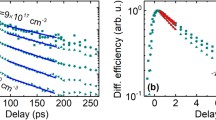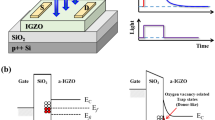Abstract
Deep level Transient Spectroscopy (DLTS), Electron Beam Induced Current (EBIC), EBIC Diffusion Length Mapping (EBIC-DLM) and contactless Photoconductive Decay (PCD) were used to characterize both bulk substrates and epitaxially grown Silicon Carbide films. Traps as deep as 0.93 eV were observed via DLTS. These traps may play a role in the persistent photoconductivity effect. EBIC reveals the electrical activity of the well known triangular defects. However, only some of these defects display electrical activity consistent with that of 3C-SiC inclusions, others do not. Additionally, not all defects identified in the EBIC images are observable in the topographic SEM image, possibly indicating a new, yet unidentified defect. EBIC revealed the electrical activity of defects including micro-pipes, dislocations (or possibly growth step edge decoration), surface polish damage, and bulk defects. Diffusion length maps of SiC indicate wide variations in diffusion length on both microscopic and macroscopic scales. EBIC-DLMindicatedepitaxial 4H SiC resulted in diffusion lengths from 0.1 to 3 'gmm, while bulk values were less than 0.07 μm. PCD measurements indicate tens of nanosecond to microsecond variations in lifetime. Lifetime verses injection level variations are observed and explained on the basis of trap energy. The injection level dependence of lifetime was observed at various nitrogen doping concentrations. Finally, electron beam annealing is found to dramatically improve the minority carrier lifetime in epitaxial SiC.
Similar content being viewed by others
References
Kittler, M. and K. W. Schroder, Phys. Stat. sol. a,, p. 139, (1983).
R. Raghunathan, B. J. Baliga, Proc. of 38th Electronic Materials Conference, June 26-28, 1996.
W. A. Doolittle, and A. Rohatgi, Rev. Sci. Instrum. 63, p. 5733 (1992).
S. Weimin, M. Dudley, K. Hua-Shuang, J. Sumakeris, C. CarterJr., J. Elect. Mat., Vol.26, no. 3, p. 151, March 1997
D. Cavalcoli, A. Cavallini, Mat. Sci. and Engin., B24, p. 98, (1994).
G. Augustine, H. McD. Hobgood, V. Balakrishna, G. Dunne, R. H. Hopkins, W. A. Doolittle, and A. Rohatgi, Proc. of Int. Conf. on SiC, III-Nitrides and Related Materials, 8/31-9/6, Stockholm, Sweden, 1997 (to be published).
Acknowledgement
The authors would like to thank Laura Rea and Henry Brandhorst for their financial and technical support under sub-contract#95-SPI-420757-GTRCof U. S. Air Force contract F33615-9425407.
Author information
Authors and Affiliations
Corresponding author
Rights and permissions
About this article
Cite this article
Doolittle, W.A., Rohatgi, A., Ahrenkiel, R. et al. Understanding the Role of Defects in Limiting the Minority Carrier Lifetime in SiC. MRS Online Proceedings Library 483, 197–202 (1997). https://doi.org/10.1557/PROC-483-197
Published:
Issue Date:
DOI: https://doi.org/10.1557/PROC-483-197




